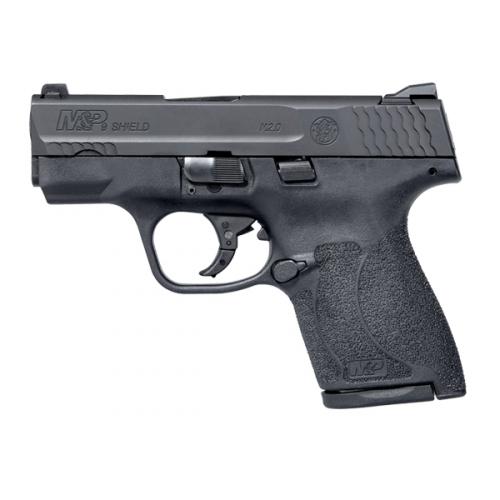As the idea of concealed carry gains traction we as consumers are provided with a world of choices and options when it comes to the subject of of carry guns. Despite this impressive variety, certain issues remain prevalent regardless of the make, model, or caliber. As pistols get smaller and lighter while shooting hotter and more powerful rounds, they can quickly become a handful (or in their case, not enough of one!) How does one contain so much ballistic power in such a small, easily concealed, and..hopefully..comfortable package?
Sometimes when all of the pieces are brought together, the end result is something which simply works. In the case of Smith and Wesson, their original line of Shield pistols placed quite respectively within the striker-fired concealment pistol category. Interest, and demand, had remained high. As it turns out, for as popular as the original had been they’ve managed to make it better.
A lot better, as it turns out.
I had an opportunity to put a few rounds downrange with a pair of 9mm specimens, one with the external thumb safety and one without, and was promptly surprised by how quickly the trigger was ready to break beneath my steady pull. The Shield 2.0’s trigger was smooth and steady from start to finish, having what I felt was exactly as much travel as it needed to get the job done. After the first shot proved just how nice of a trigger this little pistol has I was quickly sending additional rounds into the paper, and grouping very well for having never had any previous hands-on time with this sidearm.
Even though there’s limited real estate for the hands to hold onto, and admittedly it did take me a moment initially to figure out how to ‘best’ hold it, something just clicked in the back of my mind after that first shot went downrange. From that moment onward it was go-time. One mag emptied, another being loaded. Some carry guns have a mushy, resistive feel to them, like when you go to shoot it’s like trying to encourage a sleepy pet to get out of the way so you can climb out of bed. In the Shield’s case it knew what I was doing, and it was ready for it. I was struck with this very peculiar sensation while on the lane like I was shooting with a companion more than a machine.
Smith & Wesson has done a great job of retexturing the grip area of the 2.0 series, as well. There’s a lot more traction to be had in the hands without feeling abrasive or excessive, a bit like sandpaper without the grit. Upon my first exposure to a full-framed 2.0 I thought that it was more rough than necessary, though after seeing how well the Shield jumped back down onto target without wearing out my palm I came to feel differently about it. It stayed right where I needed it to be without any felt irritation. Being a female gun owner I appreciate sidearms which I don’t have to fight with after each shot. Feeling this steady with such a small nine millimeter is a refreshing change of pace, by the second shot I immediately felt confident with it.
For that matter, I found this pistol comfortable and secure enough that I could easily shoot it one-handed, regardless of which hand it happened to wind up in. It just plain did what I wanted it to do, even with the flush-fitting magazine. ‘Wow’ became the most descriptive summary which I could think of.
Additional touches include a polished feed ramp and a stainless steel chassis which houses all of the internals and secures the slide to the frame. The inner construction looked and felt smooth, solid, and simplistic. With the nine millimeter the flush mag holds 7 rounds and the extended holds 8.
The only real downside which I had experienced is the slide catch/release. While it is possible to drop the slide by pressing down on the catch it’s a very small area, and fairly resistant. Since the Shield is purpose-built for concealment it makes sense that a flush-fitted control would give the pistol one less thing to snag onto, favoring a sleek profile which will easily clear a holster or pocket. With the Shield you will want to practice grabbing the back of the slide to release it.
How does this fare, then, for the model with the manual safety? Pretty well, actually. I was able to flick the safety on or off, though flicking it off is by far the easier, and more instinctive, motion. Just a downward brush of the thumb is all that was needed to ready the pistol. Re-engaging the safety took a little more conscious thought and effort, but it can be done. I’m personally okay with this, if the safety is a bit more stiff to engage then it’s less likely to get bumped on when I don’t want it to. With the Shield I didn’t feel like this would be a concern.
In keeping with the slim profile the Shield does not have a frame-mounted rail, a feature which I don’t particularly miss as I’ve never used the rail while carrying a firearm. Tritium night sights can also be had on models without the thumb safety. Fans of larger calibers are supported as well, the Shield 2.0 is also available in .40 and .45.
I’m impressed with what Smith and Wesson has managed to accomplish with the Shield platform. Besides the technical and ergonomic improvements they’ve also managed to catch my interest in a big way. Here is a device where the name ‘shield’ feels most appropriate. I enjoyed shooting the 2.0 so much that I went back to load up another mag. Where the original M&P line as a whole had never particularly interested me, the Shield 2.0 has me reconsidering my choice of carry gun.



